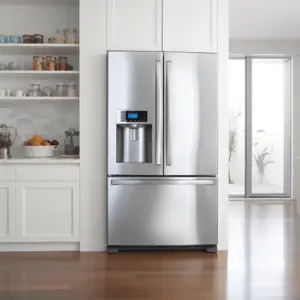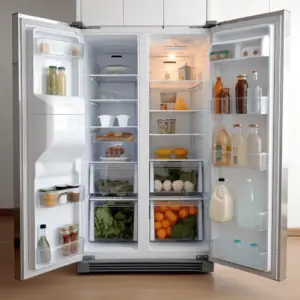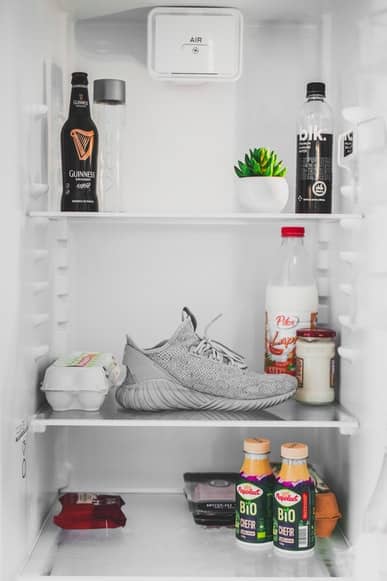Refrigerator Door Closure come with a magnetic strip around the inside edge.
This strip attracts the metal inside, causing the door to close. Likewise, if the door is close to the metal frame, it will use magnetic attraction to pull itself shut.
Another reason a refrigerator door closes automatically is because of the raised front legs. The front legs may be adjusted a few degrees upwards above the average level when you install it.
This adjustment makes the refrigerator tilt back slightly. When you open the door, gravity will cause the door to shut automatically. The door gasket has a thin magnetic strip that seals the door tightly. It is essential to raise the front feet carefully without causing damage to the contents inside the fridge.
Table of Contents
What Makes a Refrigerator Door Not Close Automatically?

When your fridge’s door does not shut tightly, warm air will get inside and may cause the contents to spoil. Here are reasons the door won’t close tightly.
You have overcrowded the door with heavy items
Stacking your fridge’s door with gallons of milk and other items pulls the door downward. It can also damage the hinges and the closing cam. If your door is overloaded, remove some items to solve the problem.
Items are blocking the door
Sometimes you may put a food container that’s too big, causing the door to block from the inside. Solve this problem by checking your fridge to see whether containers are blocking the door and replacing them.
The fridge is not level on the floor
Refrigerator Door Closure the fridge is sitting at an angle, sometimes it may not close automatically. Here’s how to level your fridge:
- Remove the grill from the bottom of the fridge to expose the feet and leveling screws.
- Grab your pliers and use them to rotate the leveling feet to lower or raise the fridge. Rotate until the bubble on the level sits between two vertical lines.
- If your fridge has leveling screws near the front feet, use a screwdriver to turn them in the direction you want until you level your fridge.
- Once in position, return the grill to its original position. If the grill is misshaped, it may cause leveling problems and will need replacing.
The fridge door seal has a problem
The fridge door seal or gasket is the rubber strip going around the edges of the door. Dirt may have accumulated on the door gasket. The dirt is not readily noticeable unless you look keenly. Check for any dirt and clean the gasket.
How to clean a fridge door gasket
- You will need a soft cloth and warm, soapy water.
- Clean the folds of the seal to remove all grime and grease from the surface.
- Use a clean cloth to wipe the gasket dry.
- Check the seal to see whether you have cleaned it properly or it requires additional care.
The door gasket is loose
Push back the gasket into the spot it is supposed to be. Use your hand to determine where the gasket is, and as you move your hand, you will feel the cold air against it.
That is the place where the gasket should be. You can make the job easier by applying oil into the groove beneath the loose rubber. Lubrication makes it easy to push the gasket into the groove.
The door gasket is cracked
Your gasket can wear out from the regular opening and closing of the fridge. If you can see tears or cracks, it may be time to replace your gasket. Refrigerator Door Closure cannot see any damages, use the paper test.
Position a piece of paper between the fridge and the door and then close it. If the paper slips out with ease. The gasket is not sealing as it should and needs replacing.
Replacing the gasket:
- Consider your appliance’s brand and model.
- Visit a local appliance repair shop or order the gasket online.
- Once you get the new gasket, remove it from its packaging and place it inside a sink or tub.
- Soak it in warm water for a couple of minutes as you remove the old gasket from your fridge
- When removing the old gasket, grab the edge of the inside part of the door and pull it upwards. You will notice a retaining plate attached under the gasket with hex screws. With a screwdriver, loosen the screws and gently pull off the gasket. If your model does not have screws, remove the gasket by simply pulling it.
- For the new seal installation, position the longer lip of the gasket behind the retainer or on the top groove, beginning with the corners. When the lip is wholly inside the door, tighten the screws and pull the gasket over them.
- When done installing, close the door to see if the new gasket is working. If it is not working, readjust it and ensure you remove any gaps.
This gasket replacement procedure works for most appliances. However, some models have additional buttons, grooves, or snaps. Refrigerator Door Closure is advisable to check the user’s manual for any other steps.
The closing cam on the door needs replacing

A malfunctioning closing cam does not allow the door to close automatically or give a tight seal. However, it would help if you considered replacing it. Here’s how to replace the closing cam:
- Empty your fridge because you will need to remove the door.
- Turn the fridge off.
- Locate the hinge cover and remove the screw holding it. Next, lift the cover to reveal the hinge.
- Use a socket wrench to remove the bolts holding the hinge and pull the hinge from the door.
- Hold the door with both hands and lift it to remove it.
- Use a flathead screwdriver to remove the closing cam from the bottom of the door and insert the new one.
- Clean the closing cam and bottom hinge with warm soapy water and dry, then lubricate for best performance.
- Return the fridge door by inserting it on the bottom and top hinge and secure it with the bolts you had removed.
- Replace the hinge cover and return the contents to your fridge, and turn the refrigerator on.
Checking and fixing such issues may seem like a lot of work, but it is simple and does not require expertise. Always ensure your fridge is in its best working condition for optimum performance.


